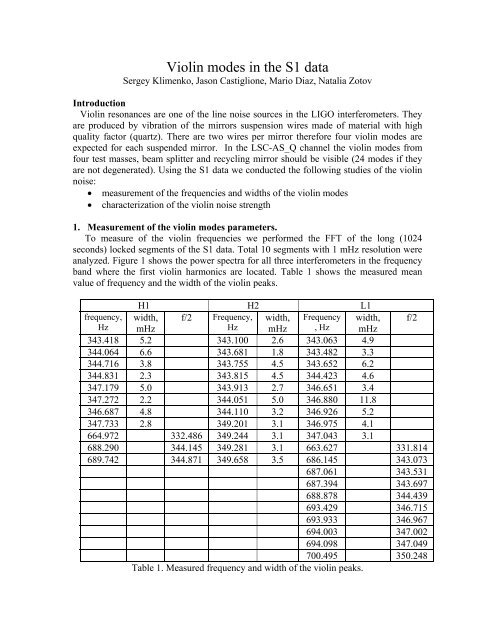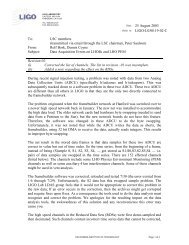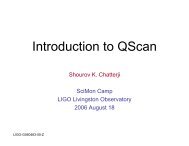Violin modes
Violin modes
Violin modes
You also want an ePaper? Increase the reach of your titles
YUMPU automatically turns print PDFs into web optimized ePapers that Google loves.
<strong>Violin</strong> <strong>modes</strong> in the S1 data<br />
Sergey Klimenko, Jason Castiglione, Mario Diaz, Natalia Zotov<br />
Introduction<br />
<strong>Violin</strong> resonances are one of the line noise sources in the LIGO interferometers. They<br />
are produced by vibration of the mirrors suspension wires made of material with high<br />
quality factor (quartz). There are two wires per mirror therefore four violin <strong>modes</strong> are<br />
expected for each suspended mirror. In the LSC-AS_Q channel the violin <strong>modes</strong> from<br />
four test masses, beam splitter and recycling mirror should be visible (24 <strong>modes</strong> if they<br />
are not degenerated). Using the S1 data we conducted the following studies of the violin<br />
noise:<br />
• measurement of the frequencies and widths of the violin <strong>modes</strong><br />
• characterization of the violin noise strength<br />
1. Measurement of the violin <strong>modes</strong> parameters.<br />
To measure of the violin frequencies we performed the FFT of the long (1024<br />
seconds) locked segments of the S1 data. Total 10 segments with 1 mHz resolution were<br />
analyzed. Figure 1 shows the power spectra for all three interferometers in the frequency<br />
band where the first violin harmonics are located. Table 1 shows the measured mean<br />
value of frequency and the width of the violin peaks.<br />
H1 H2 L1<br />
frequency, width, f/2 Frequency, width, Frequency width, f/2<br />
Hz mHz<br />
Hz mHz , Hz mHz<br />
343.418 5.2 343.100 2.6 343.063 4.9<br />
344.064 6.6 343.681 1.8 343.482 3.3<br />
344.716 3.8 343.755 4.5 343.652 6.2<br />
344.831 2.3 343.815 4.5 344.423 4.6<br />
347.179 5.0 343.913 2.7 346.651 3.4<br />
347.272 2.2 344.051 5.0 346.880 11.8<br />
346.687 4.8 344.110 3.2 346.926 5.2<br />
347.733 2.8 349.201 3.1 346.975 4.1<br />
664.972 332.486 349.244 3.1 347.043 3.1<br />
688.290 344.145 349.281 3.1 663.627 331.814<br />
689.742 344.871 349.658 3.5 686.145 343.073<br />
687.061 343.531<br />
687.394 343.697<br />
688.878 344.439<br />
693.429 346.715<br />
693.933 346.967<br />
694.003 347.002<br />
694.098 347.049<br />
700.495 350.248<br />
Table 1. Measured frequency and width of the violin peaks.
H1<br />
H2<br />
L1<br />
Figure 1. <strong>Violin</strong> resonances in the S1 data.
The typical width of the violin resonances is 3-5 mHz (see Figure 2).<br />
Figure 2. Width of the H2 violin <strong>modes</strong>.<br />
We also measured the frequencies of some second harmonics. If we divide the frequency<br />
of the second harmonics by two, the resulted frequency doesn’t match precisely any of<br />
the first harmonics. Typically they are 10-50 mHz higher. One possible explanation is the<br />
frequency shift due to the oscillation dumping<br />
ω<br />
2 2<br />
= ω 0<br />
− λ ,<br />
where ω 0 is the violin angular frequency and λ is the dumping coefficient (1/λ is the<br />
decay time). The difference between the second harmonic frequency divided by 2 and the<br />
first harmonic frequency is approximately<br />
3 2<br />
∆ ω ≈ ω0λ<br />
,<br />
8<br />
which could be 5-20 mHz for the decay time 185-60 sec respectively. In principle by<br />
measuring the frequencies of two first harmonics one can measure the dumping<br />
coefficient of the suspension wires, it’s hard to estimate the systematic errors of this<br />
measurement.<br />
2. Comparison with the previous measurements.<br />
During the E7 and S1 runs we measured the frequencies and decay time of the L1<br />
violin lines listed in Table 2.<br />
E7<br />
S1<br />
frequency, Hz decay time, sec frequency, Hz decay time, sec<br />
343.056 58 343.063 65<br />
343.665 185, 140 343.652 48<br />
346.932 64 346.926 61<br />
Table 2. Comparison of frequencies and decay time for violin resonances measured<br />
during E7 and S1 runs.
There is the order of 10 mHz difference between the S1 and E7 measurements, and we<br />
believe these are the same lines. In both cases the measurement accuracy was ~1 mHz.<br />
From here we may conclude that the violin frequency varies with time, which could be<br />
due to the temperature variation. Of course it could be due to some unaccounted<br />
systematic errors in the frequency measurement as well.<br />
Table 2 shows also the comparison of the decay time measured for three violin lines for<br />
E7 and S1 data. During the E7 run we measured the decay time directly by tracking the<br />
amplitude of the resonances as a function of time (see Figure 2). For the S1 run the decay<br />
time was estimated from the line width.<br />
Figure 2. The decay of the 343.665 Hz line with decay time of 185 sec.<br />
There is a reasonable agreement between the decay time of two lines at the frequencies<br />
343.065 Hz and 346.932 Hz. However there is a considerable disagreement for the<br />
343.665 Hz line. One possible explanation is that the 343.665 Hz line in fact consists of<br />
two (or more) <strong>modes</strong>. Figure 3 shows the frequency distribution measured with the<br />
LineMonitor during E7 run. There are three lines, which may correspond to different<br />
<strong>modes</strong>. The lines at the 343.665 Hz and the 343.668 Hz have systematically different<br />
decay time 140 sec and 185 sec respectively. Figure 3 shows the amplitude variation as a<br />
function of time for the 343.668 Hz line.<br />
Figure 3. Frequency distribution measured by the LineMonitor for 343.665 Hz line<br />
during E7 run.
3. Tracking of the violin <strong>modes</strong>.<br />
In the S1 data the amplitude of the violin resonances was very unstable. It was measured<br />
by the LineMonitor, which has the integration time of one minute. Sometimes the violin<br />
<strong>modes</strong> were excited in the beginning of the lock sections and usually they were barely<br />
seen by the LineMonitor when the detectors were in lock. Table 3 shows the frequency<br />
and duty cycle of the violin resonsnces, which can be seen by the LineMonitor.<br />
f,<br />
Hz f/2<br />
duty,<br />
% SNR<br />
f,<br />
Hz f/2<br />
duty,<br />
% SNR<br />
f,<br />
Hz f/2<br />
duty,<br />
% SNR<br />
343.49 20.27 81.1 343.36 2.03 63.7 343.94 5.65 95.9<br />
344.43 23.3 22.3 343.94 35.59 79.2 349.31 16.64 29.6<br />
346.91 55.38 23.9 344.85 0.58 24.6 683.96 341.98 0.12 36.5<br />
686.12 343.06 1.95 86.7 683.95 341.98 0.15 28.2 688.21 344.11 0.13 27.1<br />
687.22 343.61 7.86 348.0 686.93 343.47 5.76 494.0<br />
688.91 344.46 2.79 92.4 688.18 344.09 12.71 386.0<br />
689.67 344.84 0.53 68.9<br />
Table 3. <strong>Violin</strong> <strong>modes</strong> measured by the LineMonitor for the L1, H1, H2 interferometers.<br />
The duty cycle was calculated as a fraction of the lock time when the violin amplitude<br />
exceeds the LineMonitor threshold. Also the table shows the average signal to noise ratio<br />
(SNR) for the data stretches when the <strong>modes</strong> are visible.<br />
The average ratio of the violin signal PSD and the noise PSD (SNR), estimated from<br />
the FFT analysis, is approximately 3.5 for the LineMonitor integration time. Therefore an<br />
accurate tracking of the violin <strong>modes</strong> for S1 data with integration time of 1 minute is not<br />
possible.<br />
4. Other questions related to the violin noise investigation<br />
• Does the violin noise present any threat for the ongoing data analysis?<br />
<strong>Violin</strong> <strong>modes</strong> give small contribution into the variance of the detector output<br />
signal. It’s not likely that the violin <strong>modes</strong> are correlated between different<br />
interferometers, because violin frequencies are unique and the amplitudes are<br />
non-stationary. Therefore they should not be a problem for the stochastic<br />
searches. Besides they are located in the frequency band, which give small<br />
contribution to the cross-correlation. The violin noise doesn’t seem to be a<br />
problem for inspiral (too different signature) or continues waves searches. The<br />
burst analysis may suffer from the violin noise, however at the moment there is no<br />
evidence that it’s a dominant noise.<br />
• Does the violin noise affect the detector operation?<br />
• Do we need to track them during data taking? If yes, then how?<br />
Perhaps we need to track large bursts of the violin noise associated with the<br />
external excitation. Then the LineMonitor is an adequate tool for the violin<br />
tracking.<br />
• Is it important to know which mode is produced by which mirror?







